List of Canadian flags
This is a list of flags used in Canada. The Department of Canadian Heritage lays out protocol guidelines for the display of flags, including an order of precedence; these instructions are only conventional, however, and are generally intended to show respect for what are considered important symbols of the state or institutions.[1] The Queen's personal standard is supreme in the order of precedence, followed by those for the monarch's representatives (depending on jurisdiction), the personal flags of other members of the Royal Family,[2] and then the national flag and provincial flags.


Many museums across Canada display historic flags in their exhibits. The Canadian Museum of History, in Hull, Quebec has many culturally important flags in their collections. Settlers, Rails & Trails Inc., in Argyle, Manitoba holds the 2nd largest exhibit - known as the Canadian Flag Collection.
Royal
| Flag | Date | Use | Description |
|---|---|---|---|
 | 1962–present | Royal Standard of Queen Elizabeth II, Queen of Canada | A banner of the Royal Arms of Canada defaced with a royal cypher of Queen Elizabeth II |
Viceregal and administrative
Governor general
| Flag | Date | Use | Description |
|---|---|---|---|
 | 1981–1999 2002–present | Flag of the Governor General of Canada | A blue field with the crest of the Royal Arms of Canada charged in the centre |
Lieutenant governors and Commissioners
Civil and state
National
| Flag | Date | Use | Description |
|---|---|---|---|
 | 1965–present | National Flag of Canada (Maple Leaf Flag, l'Unifolié) | A vertical bicolour triband of red, white, red with a red maple leaf emblem charged in the Canadian pale |
Ceremonial
| Flag | Date | Use | Description |
|---|---|---|---|
 | 1965–present | Royal Union Flag | National flag of the United Kingdom. The Cross of St. Andrew counterchanged with the Cross of St. Patrick and over all the Cross of St. George. |
Provincial
| Flag | Date | Use | Description |
|---|---|---|---|
 | 1965–present | Flag of Ontario | A red field with the Royal Union Flag in the canton and the shield of the coat of arms of Ontario charged in the fly |
 | 1948–present | Flag of Quebec (The Fleurdelisé) | A blue field with an ordinary white cross and a white fleur-de-lis in each quadrant |
 | 1858–present | Flag of Nova Scotia | A banner of arms of the coat of arms of Nova Scotia |
 | 1965–present | Flag of New Brunswick | A banner of the coat of arms of New Brunswick |
 | 1965–present | Flag of Manitoba | A red field with the Royal Union Flag in the canton and the shield of the coat of arms of Manitoba charged in the fly |
 | 1960–present | Flag of British Columbia | A banner of the coat of arms of British Columbia |
 | 1964–present | Flag of Prince Edward Island | A banner of the coat of arms of Prince Edward Island within a bordure compony of red and white |
 | 1968–present | Flag of Alberta | A blue field with the shield of the coat of arms of Alberta charged in the centre |
 | 1969–present | Flag of Saskatchewan | A field party per fess, green and yellow, with the shield of the coat of arms of Saskatchewan in the canton and western red lily emblem charged in the fly |
 | 1980–present | Flag of Newfoundland and Labrador | A blue and white field party per pale (at nombril point) with a white border, white ordinary cross and white saltire, two triangular divisions in the fly lined in red, a golden arrow between two triangular divisions |
Territorial
| Flag | Date | Use | Description |
|---|---|---|---|
 | 1969–present | Flag of the Northwest Territories | A vertical bicolour triband of blue, white, blue with the shield of the coat of arms of the Northwest Territories charged in the Canadian pale |
 | 1968–present | Flag of Yukon | A vertical tricolour triband of green, white, blue with the shield of the coat of arms of Yukon above a wreath of fireweed charged in the Canadian pale |
 | 1999–present | Flag of Nunavut | A field party per pale, yellow and white, with a red inukshuk charged in the centre and a blue star in the upper fly |
Indigenous nations
| Flag | Date | Use | Description |
|---|---|---|---|
.svg.png.webp) | 2013–present | Proposed flag of Nunavik | The bird with wings spread, reaching for the sky, represents self-governance and freedom. The large size of the wings represent strength. Each feather represents a community in Nunavik. The symmetry of the wings represent equality. The dot represents a head and mind fully supported by the body. The wings both have five feathers, representing the fingers of human hands, symbolic of pulling yourself up and pushing yourself forward. The wings are also similar to caribou antlers, which may represent protection. The two colours represent the co-existence of being and nature, which complement each other equally |
 | 2005–present | Flag of Nunatsiavut | A white field with a white, green, and blue inukshuk charged in the centre |
 | 2018–present | Flag of NunatuKavut | The flag features an ulu, a traditional Inuit knife used by women. Within the ulu image is a dog sled team, showing the importance of husky dogs, as well as a kudlik, a traditional seal oil lamp |
.svg.png.webp) | Unknown–present | Flag of the Mi'kmaq Nation Grand Council | A white field with a red Latin cross and a red star and moon in the left quadrants; white denotes purity of creation, the red cross represents mankind and infinity, the sun and moon the forces of day and night,[3] the flag is meant to be displayed hanging vertically as shown here[4] |
 | 1980s–present | Flag of the Haudenosaunee Confederacy | A mauve field party per fess by a band of white squares joined and a stylized white "Tree of Peace" charged in the centre; design is adapted from the Hiawatha wampum belt, each element represents an original nation in the confederacy |
 | Unknown–present | Flag of the Innu Nation | Horizontal bands of teal, white and light blue, within the blue sits a centre snowshoe flanked by reindeer skulls on both sides |
%252C_Quebec.gif) | Unknown–present | Flag of the Matimekush Band | A vertical tricolour triband of chartreuse, white, green with the coat of arms of the Matimekush Lac John Band charged in the Canadian pale |
 | Unknown–present | Flag of the Anishinaabek | A black pictographic thunderbird on a white field |
 | Mid-1980s–present | Flag of the Natuaqanek Band | A red field with yellow left and right borders, a quartered roundel charged in the centre[3] |
 | Unknown–present | Flag of Ĩyãħé Nakón Mąkóce (Stoney Nakoda) | Stoney Nakoda flag |
 | 2005–present | Flag of the Ktunaxa Nation | Flag features a golden feathered staff on a brown field |
| Unknown–present | Flag of Secwepemcúl̓ecw | Flag features 17 feathers representing the 17 bands in the Secwépemc Nation. The feathers are mostly black, with a white portion in the middle. The white portion signifies those communities which were wiped out by disease and other trauma following contact | |
 | 1980–present | Flag of the Nlaka'pamux Nation | Circle wreath of Nlaka'pamux pictographs set on a grey field |
 | Unknown–present | Flag of the Haida Nation | A red field with an eagle and raven headed bird, surrounded by a circlet, charged in the centre |
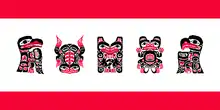 | 2012–present | Flag of Deisleen Ḵwáan, Lingít Aaní | Horizontally striped, red-white-red, 1-3-1, with five totems or emblems in the centre, from left to right: Kùkhhittàn (Raven Children), Ishklitàn (Frog), Yanyèdi (Wolf), Sèshitàn (Beaver), Dakhlʼawèdi (Eagle) |
 | Unknown–present | Flag of the Tahltan Nation | Flag of Tahltan Kolīne representing the two clans: Crow (or Tseskʼiya) and Wolf (or Chʼioyone) |
 | 2001–present | Flag of the Nisg̱aʼa Nation | A vertical tricolour triband of black, white, and sanguine with the badge of the Nisga'a Nation,[5] surrounded by black and sanguine ovals, charged in the Canadian pale[6] |
 | Pre-1816–present | Flag of the Métis Nation of Canada | A blue field with a white symbol of infinity charged in the centre (French descent) |
 | Pre-1816–present | Flag of the Métis Nation of Alberta | A red field with a white symbol of infinity charged in the centre (British descent) |
Francophone peoples
| Flag | Date | Use | Description |
|---|---|---|---|
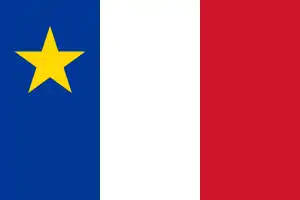 |
1884–present | Acadian flag | Tri-colored flag, blue, white then red. A yellow star representing independence and unique culture from main land France. |
 | 1975–present | Flag of the Franco-Ontarians | A field party per pale, green and white, with a white fleur-de-lys charged in the hoist and a green trillium emblem charged in the fly |
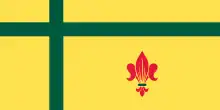 | 1976–present | Flag of the Fransaskois | A yellow field with a green Nordic cross centred towards the upper hoist and a red fleur-de-lis charged in the lower fly |
 | 1980–present | Flag of the Franco-Manitobans | A white field with yellow over sanguine bars with a green plant emblem in four pieces charged in the hoist |
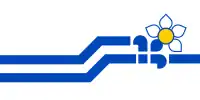 | 1981–present | Flag of the Franco-Columbians | A white field party per pale by a bar gemelles and dancetty, a fleur-de-lys and Pacific Dogwood emblem charged in the fly; Dogwood is the floral emblem of British Columbia, the blue stripes evoke the Pacific Ocean and the rising mountains beside, the yellow centre of the Dogwood flower represents the sun |
 | 1982–present | Flag of the Franco-Albertans | A field party per bend sinister, blue and white, by a bend cotised white and blue with a white fleur-de-lys in the upper hoist and a red wild rose in the lower fly |
 | 1985–present | Flag of the Franco-Yukonnais | A blue field and three diagonal stripes set from lower hoist to upper fly. The colours of the stripes are white and golden yellow. The effect created by the arrangement of the stripes is meant to represent Yukon's many mountains. Blue is for the French people and the sky. White is for winter and snow. Yellow represents the gold rush and the Franco-Yukonnais contributions to history of the territory. |
 | 1986–present | Flag of the Fédération des Francophones de Terre-Neuve et du Labrador (Franco-Terreneuviens) | Three unequal panels of blue, white, and red, with two yellow sails set on the line between the white and red panels. The sail on top is charged with a spruce twig, while the bottom sail is charged with a pitcher flower. |
 | 1992–present | Flag of the Franco-Ténois | A polar bear on a snowy hill, looking forward towards a snowflake/Fleur-de-lis combined, representing the French community of the Northwest Territories of Canada. |
 | 2002–present | Flag of the Franco-Nunavois | Blue that represents the Arctic sky and white recalls the snow, abundantly present on the territory. The principal shape represent an igloo, and under this one, the inukshuk which symbolise the human presence. A single dandelion flower grows from beneath it. |
Military, police, coast guard and border services
Canada Border Services Agency
| Flag | Date | Use | Description |
|---|---|---|---|
 | 2012–present | Flag of the Canada Border Services Agency | A Blue field with the National Flag of Canada in the canton and the Canada Border Services Agency badge charged in the fly |
Canadian Armed Forces
| Flag | Date | Use | Description |
|---|---|---|---|
 | 1968–present | Flag of the Canadian Armed Forces | A white field with the National Flag of Canada in the canton and the Canadian Armed Forces badge charged in the fly |
 | 1968–present | Canadian Naval Ensign | A white field with the National Flag of Canada in the canton and charged in the fly with an anchor, eagle and naval crown in blue |
 | 1968–present | Canadian Forces Auxiliary Jack | A blue field with the National Flag of Canada in the canton and charged in the fly with an anchor, eagle and naval crown in white |
 | 2016–present | Flag of the Canadian Army | A scarlet red field with the National Flag of Canada in the canton and the Canadian Army badge charged in the fly |
 | 1982–present | Royal Canadian Air Force Ensign | A field of air force blue with the National Flag of Canada in the canton and the Royal Canadian Air Force roundel charged in the fly |
 | c. 1964–present | Flag of the Canadian Navy Board | A field party per bend, blue and sanguine, with a fouled anchor in gold charged in the centre |
 | 1920–present | Flag of the Royal Military College of Canada | A field tierced per pale, red, white, and red with the badge of the Royal Military College of Canada charged in the centre |
 | 1920–present | Flag of the Royal Military College Saint-Jean | A field tierced per pale, blue, white, and blue with the badge of the Royal Military College Saint-Jean charged in the centre |
 | 2000–present | Banner of the Commander-in-Chief Unit Commendation | A field tierced per pale, blue, red, and azure, with the crest of the Royal Arms of Canada charged in the centre |
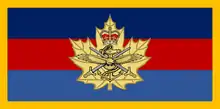 | 2009–present | Camp flag of the Cadet Instructors Cadre | The badge of the Cadet Instructors Cadre, with the traditional colours of the Navy, Army and the Air Force. The golden border represents the young people that CIC officers work for. |
Coast Guard
| Flag | Date | Use | Description |
|---|---|---|---|
 | 1962–present | Flag of the Canadian Coast Guard | A banner of the arms of the Canadian Coast Guard: vertical diband of white and blue, a red maple leaf emblem charged in the hoist and a pair of fish in gold and facing opposite directions charged in the fly |
Police
| Flag | Date | Use | Description |
|---|---|---|---|
 | 1991–present | Ensign of the Royal Canadian Mounted Police | A red field with a blue canton bordered yellow with a representation of the Badge of the RCMP |
| 1998–present | Flag of the Ontario Provincial Police | Blue with the heraldic badge of the OPP | |
| Link | 1983–present | A green field, on a Canadian Pale Yellow charged with the badge of the Sûreté du Québec |
Canadian Cadet Organisations, Cadet Leagues and the Navy League Cadets
| Flag | Date | Use | Description |
|---|---|---|---|
 | 1976–present[7] | Flag of the Royal Canadian Sea Cadets | A white flag with a Canadian Flag at the canton, with the badge of the Royal Canadian Sea Cadets at the fly. |
.svg.png.webp) | 1953–1976[7] | Former flag of the Royal Canadian Sea Cadets | A white flag with a Union Flag at the canton, with the badge of the Royal Canadian Sea Cadets at the fly. This is the basis of the current flag of the Royal Canadian Sea Cadets. |
 | 2009–present[8] | Flag of the Navy League of Canada | A white flag with a Canadian Flag at the canton, with the current badge of the Navy League of Canada at the fly. |
 | 1985–present[9] | Banner of the Royal Canadian Army Cadets | A Canadian Flag in the same shape as a Queen's Colours used in the Canadian Armed Forces, with the maple leaf modified with the badge of the Royal Canadian Army Cadets. At the canton, the cypher of General HRH The Prince Philip, Duke of Edinburgh as Colonel-in-Chief of the Royal Canadian Army Cadets. At the fly, a badge representing the Canadian Army (the crown of Saint Edward above crossed swords). |
 | January 1973–present | Flag of the Royal Canadian Army Cadets used by individual Army Cadet Corps. | |
.png.webp) | 1944–1973 | Flag of the Royal Canadian Army Cadets used by individual Army Cadet Corps used before 1973. | |
 | ?? | Camp Flag of the Royal Canadian Army Cadets. | On a white field, the badge of the Royal Canadian Army Cadets in the centre. |
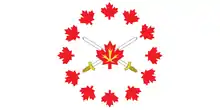 | 1995–present [10] | Flag of the Army Cadet League of Canada. | A banner of the shield of the arms of the Army Cadet League of Canada. According to the heraldic grant, the shield of the arms of the Army Cadet League of Canada is "Argent two swords in saltire Argent fimbriated Gules hilted and pommelled Or surmounted by a maple leaf Gules veined Or all within an orle of twelve maple leaves stems inward Gules."[11] The web site of the Governor General of Canada explains this description as follows: "The white shield, bearing a maple leaf and crossed broad swords, alludes to a central Canadian entity with direct connection to the military. The twelve smaller maple leaves show singleness of purpose but at the Branch level.[11] |
 | 1991–present [12][9] | Banner of the Royal Canadian Air Cadets | Based on the design of Queen's Colours for the Royal Canadian Air Force, with the badge of the Royal Canadian Air Cadets replacing the maple leaf. At the canton, the cypher of General HRH The Prince Philip, Duke of Edinburgh as Air Commodore in Chief of the Royal Canadian Air Cadets. On the bottom fly, the first badge of the Royal Canadian Air Cadets, a golden maple leaf above an eagle. |
| 1971–present [12] | Ensign of the Royal Canadian Air Cadets | An Air Force blue flag, with a Canadian flag at the canton, with the historical badge of the Royal Canadian Air Cadets. | |
.png.webp) | ??? | Squadron Banner of the Royal Canadian Air Cadets | An Air Force blue flag, with the badge of the Royal Canadian Air Cadets and a scroll stating the squadron's name and number (this example, 643 St-Hubert Squadron. |
Municipal
Crown corporations
| Flag | Date | Use | Description |
|---|---|---|---|
 | ?-present | Flag of the Royal Canadian Mint | A red field with the logo of the Royal Canadian Mint charged in the centre; logo was first introduced in 1978 |
Historical flags
National flags
| Flag | Date | Use | Description |
|---|---|---|---|
 |
1497–1707 | Flag on John Cabot's ship, and used during the English colonization of the Americas before the Act of Union. | White Ensign, St George's Cross. |
.svg.png.webp) |
1621–1707 | Flag used during the Scottish colonization of the Americas before the Act of Union. | White saltire on blue ensign, St. Andrew's Cross. |
 |
1534–1604 | Flag of France at the time of Jacques Cartier. | |
 |
1643 | Royal Standard of France. | |
.svg.png.webp) |
1689 | Merchant Flag of France | |
.svg.png.webp) |
1763–1801 | Flag of Great Britain | |
 |
1801–1964 | Flag of the United Kingdom (1801–1964); Canadian Royal Union Flag (1964–present) | |
.svg.png.webp) |
1868-1921 | Canadian version Red Ensign and civil flag until 1921. | |
.svg.png.webp) |
1905-1922 | 1907 Canadian Red Ensign commonly used in western Canada. Note the inclusion of all the provincial emblems. | |
.svg.png.webp) |
1921-1957 | Canadian version Red Ensign and civil flag until 1957. | |
.svg.png.webp) |
1957-1965 | 1957 version of the Canadian Red Ensign that had evolved as the de facto national flag until 1965. | |
Vice-regal flags
Military flags
| Flag | Date | Use | Description |
|---|---|---|---|
 | RCN (1911–1965)
RCSCC (1905–1965) |
Used as the ensign of the Royal Canadian Navy and some Royal Canadian Sea Cadets corps. Used throughout the entire British Empire by the Royal Navy and by several former British colonies even after they became independent and established their own navies. | White Ensign, St George's Cross with the Union Flag in the canton. |
.svg.png.webp) | RCN (1921–1957)
RCSCC (1929–1953) |
The Blue Ensign, worn as a jack by the Royal Canadian Navy and used by the RCSCC | Blue Ensign defaced with the Royal Arms of Canada. The maple leaves at the bottom of the shield are green. |
.svg.png.webp) |
1939–1944 | Canadian Army Battle Flag | White Ensign. Designed by Colonel Archer Fortescue Duguid, Director of Historical Section, General Staff, National Defence Headquarters. |
.svg.png.webp) |
1989–1998 | Force Mobile Command flag | |
.svg.png.webp) | 1957–1965 | Final version of the Blue Ensign, worn as a jack by the Royal Canadian Navy and as an ensign by royal yacht clubs in Canada | Blue Ensign defaced with the Royal Arms of Canada. The maple leaves at the bottom of the shield are red. |
.svg.png.webp) | 1941–1965 | Royal Canadian Air Force Ensign | A field of air force blue with the Union Flag in the canton and the Canadian roundel in the middle of the fly. |
 | ?−1965 | Based King's Colour, as used by the Royal Military College of Canada | King's Colour of the Royal Military College of Canada with the Union Flag. |
Civil flags
| Flag | Date | Use | Description |
|---|---|---|---|
.svg.png.webp) | 1922–1923 | Canadian Civil Aviation Ensign, briefly used by the Air Board. | A field of light blue with the Union Flag in the canton and a shield with white albatross superimposed upon three maple leaves in the middle of the fly. |
Hudson's Bay Company
Others/non-official flags
| Flag | Date | Use | Description |
|---|---|---|---|
 | 1946 | Proposed Flag for Canada | A red British ensign defaced with a large golden maple leaf outlined in white in the fly. |
 | 1965 | Canadian flag proposal by the Native Sons of Canada | Party per bend Gules and Argent a maple leaf Gules |
 | 1965 | Proposed Flag for Canada, known as the Pearson Pennant | A blue field with a white square containing a three-leaf maple. The blue sides were meant to represent John A. Macdonald's description of the Canadian Pacific Railway and Canada's geography, "From sea to sea". |
 | 1994 | Proposed flag for Canada, known as the Canadian Unity Flag | Blue vertical stripes replacing part of the red bands, in approximate proportion to population of French heritage. |
.svg.png.webp) | 1832–present | Patriote flag | The proposed flag of Republic of Lower Canada in 1838, still used nowadays by some souverainists, in mostly 4 variants: the original, and three versions with the yellow star in the top left corner. Of which, two of them have Henri Julien's Patriot painting of 1904, one in colour and the other stylised in black and white. |
 | 1837–1838 | Flag of the Republic of Canada | Two white stars representing the colonies of Upper and Lower Canada on the upper half with "LIBERTY" inscribed on the lower half. |
 | 1880s–present | Newfoundland Tricolour | A field tierced per pale green, white, and pink |
 | 1884–present | Flag of Acadia | A field tierced per pale, blue, white, and red, with a gold star in the upper hoist. Common in Prince Edward Island, New Brunswick, Quebec, and Nova Scotia. |
 | 1938–present | Flag of Saguenay–Lac-Saint-Jean | A field party per fess, green and yellow, with a red-bordered grey ordinary cross; green represents the region's forests, yellow its agriculture, grey its industry and commerce, and red the vitality of the population |
 | 1974–present | Flag of Labrador | A field party per fess, white and azure, with a green horizontal band across the centre and a spruce twig in the upper hoist |
 | 1988–present | Flag of Vancouver Island | A Blue Ensign defaced with the great seal of the Colony of Vancouver Island. Used informally today.[13] This unofficial flag was designed in the 1980s to retroactively represent the colony (1849–1866). In 1865 the Crown gave colonies permission to place their badges on the fly of the Blue Ensign; thus vexillologists could argue that this flag is official.[14] |
 | 1988–present | Flag of Western Canada | Originally used by the Western Independence Party, it was designed in 1988 ahead of the party's first election. |
.svg.png.webp) | Disputed-present | Flag of Cape Breton Island | A field tierced per forest green and white, with a green saltire and yellow circle reading "Cape Breton Island" on the top, and "Canada" on the bottom, with a green stylized map of Cape Breton Island in the middle. The green is taken from the island's tartan.
Though being the most commonly used flag it is not the official flag and is disputed by supporters of the officially recognized 1993 flag designed by Kelly Gooding[15] |
 | 2008–present | Flag of Gaelic Canadians | Adopted by the Comhairle na Gàidhlig (The Gaelic Council of Nova Scotia), the salmon represents the gift of knowledge in the Gaelic storytelling traditions of Nova Scotia, Scotland and Ireland and the Isle of Man. The “G” represents the Gaelic language and the ripples are the manifestations of the language through its rich culture of song, story, music, dance and custom and belief system. |
See also
Notes
References
- Department of Canadian Heritage. "Ceremonial and Canadian Symbols Promotion > Flag Etiquette in Canada". Queen's Printer for Canada. Retrieved 18 September 2010.
- Department of Canadian Heritage. "Ceremonial and Canadian Symbols Promotion > Personal Flags and Standards". Queen's Printer for Canada. Retrieved 18 September 2010.
- "Canada > Index of Pages > First Nations > Mikmaq". Flags of the World. ISSN 1712-9842. Archived from the original on 4 July 2017. Retrieved 20 September 2010.
- "Flags of the World". Archived from the original on 2017-07-04. Retrieved 2010-09-20.
- Canadian Heraldic Authority. "The Public Register of Arms, Flags and Badges of Canada > Nisga'a Nation". Queen's Printer for Canada. Retrieved 20 September 2010.
- "Canada > Index of Pages > First Nations > Nisga'a Nation". Flags of the World. ISSN 1712-9842. Archived from the original on 6 October 2010. Retrieved 20 September 2010.
- http://fraser.cc/FlagsCan/Nation/NatDefence.html
- http://reg.gg.ca/heraldry/pub-reg/project.asp?lang=e&ProjectID=1985
- https://www.canada.ca/en/services/defence/caf/military-identity-system/heritage-manual/chapter-4/annex-a.html
- https://reg.gg.ca/heraldry/pub-reg/project-pic.asp?lang=e&ProjectID=526&ProjectElementID=1845
- https://reg.gg.ca/heraldry/pub-reg/project-pic.asp?lang=e&ProjectID=526&ProjectElementID=1841
- Department of National Defence (2001-01-05). A-AD-200-000/AG-000 The Honours, Flags and Heritage Structure of the Canadian Forces Chap 4 Annex A. Directorate of History and Heritage.
- FOTW Flags of the World: Vancouver Island (British Colony, Canada)
- Flags of Canada: British Columbia
- www.capebretonpost.com https://www.capebretonpost.com/sports/football/woman-wants-cape-breton-flag-designed-by-her-daughter-recognized-17897/. Retrieved 2020-09-30. Missing or empty
|title=(help)
External links
| Wikimedia Commons has media related to Flags of Canada. |